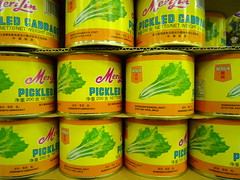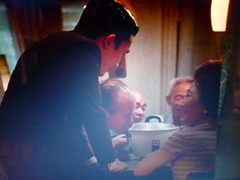 fig. a: the rice cooker is unveiled
fig. a: the rice cooker is unveiled
The premise:
In some ways, our whole month could have been inspired by this scene from Wong Kar Wai's In the Mood for Love. It's 1962 and Mrs. Chan's (Maggie Cheung) imported electric rice cooker (from Japan, of course) causes quite a stir--no one in their Hong Kong apartment complex has ever seen anything like it. The rice cooker is a vision of modernity--one of many--but like every other such vision in Wong's film, it's an ambivalent one. It's tied to both romance and heartbreak. At this point in the film, however, the rice cooker is still simply an innocent novelty, and it generates a considerable amount of excitement and enthusiasm.
At the beginning of March, we took a pledge that had a lot to do with the excitement generated by our own newly acquired rice cooker: all-Asian, all month. Most of the month was spent trying out Far East Asian recipes (Chinese, Japanese, Korean), but we also made a whole lot of Southeast Asian food (mostly Vietnamese), and towards the end of the month we began to steer things towards South Asian cuisine (especially Indian). A few of these dishes were noodle-based (like Mrs. Chan and Mr. Chow [Tony Leung], the two of us are both serious noodle lovers), but for the most part, because of the rice cooker, these meals were rice-based. As the month proceeded, we began to lovingly refer to the experiment as March Madness.
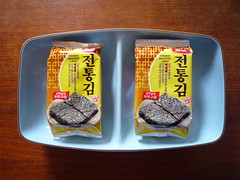 fig. b: lavers!
fig. b: lavers!
The pitch:
Michelle was seriously psyched (maybe even hyped) about the prospect of an Asian banquet for her birthday, one that she was sure would be the crowning achievement of March Madness. She loved the idea of a big spread with lots of rice fresh from our rice cooker, lots of side dishes and condiments, and seasoned lavers to pick everything up with. She also liked the idea of people milling about and mingling, instead of our usual sit-down affairs. But when I asked her if she had any special requests, she said she wanted to build the party around some kind of activity. At first I thought she was just being difficult, but then it dawned on me...
What if we threw a big Asian-themed banquet at a bowling alley? We could rent a few lanes, invite about 15-20 people, haul in a big homecooked Asian spread, and plug in our rice cooker to make fresh rice. I was imagining one of those big bashes Elvis used to throw in the early days of his stardom, when he'd rent out an entire bowling alley or roller skating rink from closing hour until dawn so he could pal around with his friends--only, instead of fried peanut butter and banana sandwiches, there'd be things like Hawaiian-style ribs (after all, Elvis loved Hawaii, didn't he?). Anyway, we'd call the event Rice Bowl (pretty catchy, huh?) and though the sticky fingers might not make for too many perfect games, I thought it would make for an unforgettable birthday bash.
The problem:
As it turns out, no bowling alley or salon de quilles in Montreal will allow you to bring any food. Presumably because they all house concessions. Most of them won't even let you bring a birthday cake, unless it's for a kid's birthday. I begged and pleaded, but to no avail. I even laid the name of the event on them. Nada.
Then I thought, "Well, if we can't bring the spread to the bowling alley, maybe we can bring the bowling alley to the spread." So I got on the horn to see if someone had a Wii + Wii Sports (which I'd heard comes with simulation bowling) they'd be happy to loan for a good cause. I found plenty of Wiis, but no one willing/foolish enough to let us get our grubby hands all over their beloved vids.
So we scrapped the Rice Bowl concept and focused strictly on the food. Go ahead and use it, though. Seriously. If you happen to live in a town with bowling alleys that aren't so uptight about trucking in food, or if you have the moulah to rent out an entire bowling alley, Elvis-style, or if you happen to own a Wii, feel free to host your own Rice Bowl event. I mean it. It's yours.
The recipes:
The following are some of the highlights from our menu.
This is kind of a strange hybrid dish that we created, but it turned out to be one of the night's most popular dishes. The basic idea behind it--poaching the Vietnamese meatballs in soup--is a classic. Poaching them in a dashi was our idea.
Shiitake Dashi w/ Vietnamese Meatballs
For the meatballs:
1 lb boneless, skinless chicken breasts
1 1/4 lb boneless, skinless chicken thighs
1 tbsp baking powder
2 tbsp tapioca starch
1 tbsp sugar
5 tbsp fish sauce
3 tbsp canola oil
Slice the breasts and thighs across the grain into 1/4-inch-thick strips. Keep any visible fat for richness, but trim away any cartilage or sinewy bits to make it easier to process.
Whisk together the baking powder, tapioca starch, sugar, fish sauce, and oil in a bowl large enough to hold the chicken. Add the chicken and use a rubber spatula to mix well. Cover with plastic wrap and marinate in the refrigerator for at least 8 hours and ideally overnight. The chicken will stiffen as it sits.
Remove the chicken from the refrigerator and use a spoon to separate the pieces somewhat. Working in batches, grind the chicken in a food processor until a smooth, stiff, light pink paste results. (This step will take several minutes, and it'll really give your food processor a good workout.) Stop the food processor from time to time to scrape down the sides. When you are finished, there should be no visible bits of chicken and the paste should have a slight sheen to it. Using the rubber spatula, transfer each batch to another bowl.
This paste is the basis for a number of Vietnamese preparations (like sausages), but it can also be shaped into quenelle-shaped meatballs (using two spoons to shape them) and poached in soup, and that's exactly what we did.
This recipe will make an enormous number of quenelle-shaped meatballs. We made about 40-50 (roughly 3 per person) and froze the rest of the meat paste for later use.
For the soup:
16 medium dried shiitake mushrooms
4 cups water
salt
light soy sauce
sake
Bring water to boil in a saucepan. Add the mushrooms to the boiling water and simmer without a lid for 5-8 minutes. Remove the mushrooms and flavor to taste with salt, soy sauce, and sake.
Save the mushrooms and use them in another preparation.
Add the meatballs to the soup. When they float to the surface, let them simmer, uncovered, for 10 to 12 minutes, or until cooked through. The meatballs will impart a subtle flavor to the broth. Adjust the seasonings and serve in bowls with one or two meatballs per bowl.
Serves 12 as an appetizer.
[recipe combines elements from recipes found in Andrea Nguyen's Into the Vietnamese Kitchen and Soei Yanada's The Heart of Zen Cuisine]
March Madness was all about the rice, but it was also all about the Asian pickles. Along with the
Carrot and Daikon Pickle featured in an earlier
post, our other favorites were these two. If you have a mandolin (the kitchen tool, not the musical instrument), you're going to love this first one. (Actually you'll probably love it either way, but you'll only be able to
make it if you have the kitchen tool variety.) No need to buy that weird dyed stuff at the store anymore.
Pickled Ginger
1 lb young ginger (use the freshest, most perfect ginger you can find)
2 tbsp sea salt
2 cups rice vinegar
3/4 cup sugar
Peel the ginger. Use a mandolin to slice the ginger crosswise very thin.
Place the ginger slices in a bowl and add 1 teaspoon of the salt. Toss with your fingers to blend well, and let stand for 10 minutes. Meanwhile, put a small pot of water on to boil. Rinse off the ginger with the boiling water and drain well.
Place the vinegar, sugar, and the remaining 1 tablespoon plus 2 teaspoons salt in a small nonreactive pot and heat, stirring, until the sugar has entirely dissolved. Meanwhile, fill a wide-mouthed 1-quart jar with boiling water, then drain it.
Using tongs, place the ginger in the jar, then pour the hot vinegar mixture overtop. Cover tightly and let the pickled sit overnight before using. The ginger keeps, well sealed in the refrigerator, for 2 months or more.
[recipe from Jeffrey Alford and Naomi Duguid's Seductions of Rice]
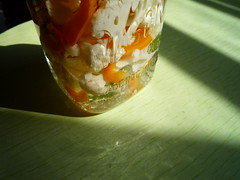 fig. c: Viet-style mixed vegetable pickle
fig. c: Viet-style mixed vegetable pickle
Mixed Vegetable Pickle
1/4 cup salt
3 cups lukewarm water
1 large bell pepper (red, yellow, or orange), seeded and cut into strips 1/2 inch wide and 1 1/2 inches long
2 large carrots, peeled and cut into matching pieces
1 small head cauliflower, trimmed and cut into 1-inch florets
2-3 hot green chiles, chopped into thin rounds
2 cups distilled white vinegar
1 1/4 cups sugar
2 cups cold water
Combine the salt and the lukewarm water in a large bowl and stir with your hand to dissolve. Add all the vegetables. The water should just cover them--if it doesn't, add more lukewarm water as needed. Set aside for 4-6 hours. The vegetables will soften and become slightly chewy.
Meanwhile, prepare the brine. In a saucepan, combine the vinegar, sugar, and cold water and heat over medium heat, stirring occasionally until the sugar has dissolved. Remove from the heat and set aside to cool completely.
When they're done, drain the salted vegetables, but do not rinse them. Put them in a 2- or 3-quart glass container. Pour in just enough brine to cover and discard the remainder. Cover the container and refrigerate overnight. The pickle is ready to eat the next day. It will keep well in the refrigerator for about 3 weeks. After that, it will lose its edge.
[adapted from Andrea Nguyen's Into the Vietnamese Kitchen]
This next recipe is unbelievably simple and remarkably satisfying. It's also 150% vegetarian.
Mushroom & Tofu Salad
1/2 pound shiitake mushrooms, stems trimmed and saved
2 small rectangles Japanese fried tofu
1 tbsp soy sauce
1 tsp rice vinegar
1 tsp sake
1/4 tsp sugar
togarashi
Grill the mushrooms and tofu square directly over a gas flame or grill, turning them with tongs to ensure they are golden on all sides. OR, place on one or two small baking sheets under the broiler and broil until the mushrooms are tender and the fried tofu is touched with brown.
Slice the mushrooms into narrow strips, discarding any tough parts. Cut the tofu into strips the same length as the mushroom strips. Place in a shallow serving bowl.
In a small nonreactive saucepan, heat the soy sauce, vinegar, and sake. When they are warm, stir in the sugar until dissolved. Let cool slightly, then pour over the mushrooms and tofu and stir gently to coat. Sprinkle lightly with togarashi and serve.
[recipe from Jeffrey Alford and Naomi Duguid's Seductions of Rice]
Hands down--no ifs, ands, or buts about it--our two most popular dishes of the evening were these next two: the spicy-sweet Hawaiian style ribs, and the Vietnamese-style glazed duck legs. Both literally vanished into thin air.
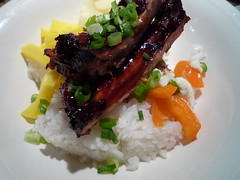 fig. d: ribs & rice
fig. d: ribs & rice
Hawaiian-Style Kalbi
1 1/4 cups light brown sugar
1 cup soy sauce
1 tbsp Asian sesame oil
1/4 tsp crushed red chile flakes
4 cloves garlic
1 2-inch piece peeled fresh ginger, finely chopped
3 lbs pork baby back ribs
3 scallions, thinly sliced
Whisk together the brown sugar, the soy sauce, the sesame oil, the chile flakes, the garlic, the ginger, and 1/4 cup of water in a large bowl. Add the ribs and toss to coat. Cover the bowl with plastic wrap and let marinate for at least 1 hour at room temperature, or refrigerate overnight, turning occasionally to coat.
Heat the oven to 450º F. Remove the ribs from the marinade and arrange, curved side up, on a rack set over a rimmed, foil-lined baking sheet. Roast for 20 minutes.
Meanwhile, heat the marinade in a saucepan over medium-high heat and simmer, stirring occasionally, until thick and syrupy, about 20 minutes.
Using tongs, flip ribs and cook, basting frequently with the reduced marinade, until the ribs are browned, glazed, and tender, 15-20 minutes. Transfer to a serving platter and garnish with the scallions.
[recipe from Saveur's March 2009 issue]
Honey-Roasted Duck Legs
4 cloves of garlic, smashed with the broad side of a knife
1" piece of fresh garlic, thinly sliced and smashed with the broad side of a knife
3/4 tsp Chinese five-spice powder
1/4 tsp salt
6 tbsp honey
2 tbsp light (regular) soy sauce
1 tbsp dark (black) soy sauce
1 tbsp Shaoxing rice wine or dry sherry
3/4 tsp salt
2 tbsp Shaoxing rice wine or dry sherry
2 tsp peeled and grated ginger, pressed through a fine-mesh sieve to extract 1 tsp ginger juice
6 whole duck legs, trimmed of excess fat and skin
2 tbsp hoisin sauce
special equipment: steamer
To make the glaze, in a small saucepan, combine the garlic, ginger, five-spice powder, salt, honey, light and dark soy sauces, and wine. Place over medium heat and bring to a boil. Remove from the heat. When the bubble action ceases, pour the glaze through a fine-mesh sieve placed over a medium-sized bowl, pressing on the solids with the back of a spoon to extract as much liquid as possible. Let the glaze cool completely.
Select a large, shallow bowl or a deep plate that fits in your steamer tray. Add the salt, wine, and ginger juice and stir to dissolve the salt. Add the duck legs and use your fingers to coat the duck legs well with the marinade. Arrange the duck legs so that there is minimal overlap, to ensure even cooking. Put the bowl in the steamer tray and set aside to marinate for 15 minutes.
Fill the steamer pan halfway with water and bring to a rolling boil over high heat. Add the steamer tray, cover, and steam the duck for 25 minutes. The skin will pull back from the flesh, and cooking juices will collect in the bowl. Transfer the duck legs to a plate and discard the cooking juices.
Position a rack in the lower third of the oven and preheat to 425º F. To promote heat circulation and allow the fat to drip away from the duck, place a flat roasting rack on a foil-lined baking sheet. Put the duck, skin side up, on the rack, spacing the legs as far apart for one another as possible. Roast for 35 to 40 minutes, or until the skin is crisp and lightly golden. Turn on the exhaust fan as the duck roasts, because the dripping fat can cause a fair bit of smoke. If more than 2 tbsp of fat accumulates in the pan during roasting, remove the duck from the rack, make a spout in one corner of the foil, and pour off the fat. Then quickly return the duck to the rack and continue roasting. (We had to execute this step twice.)
When the duck is ready, using tongs, lift each leg from the rack, roll it in the glaze to coat evenly, and hold it above the bowl to allow the excess glaze to drip off. Return the duck to the rack, skin side up. Roast the legs for 5 minutes and then coat them with the glaze again. Roast for 3 to 5 minutes longer, or until the glaze richly colors the duck. Remove from the oven and let cool for 10 minutes.
After glazing the duck legs the second time, return the remaining glaze to the small saucepan and add the hoisin sauce to make a dipping sauce. Warm over medium heat, adding a spoonful or two of water if needed to balance out the flavor. Pour into a small serving bowl.
Using a heavy cleaver, chop the legs through the bone into bite-sized pieces. Or, slice the meat off the bone. Or, just serve the legs whole and let people chomp into them Friar Tuck-style, like we did. In any case, arrange the duck on a platter and serve with the sauce.
If you have any leftovers (highly unlikely, given how incredibly juicy and delicious these duck legs are), you might want to use the duck meat as the "boldly flavored meat" in your very own homemade bánh mì.
[recipe from Andrea Nguyen's Into the Vietnamese Kitchen]
aj
 fig. a: on the grill
fig. a: on the grill fig. b: all-dressed
fig. b: all-dressed fig. c: Ritual in da house
fig. c: Ritual in da house fig. d: standing at the crossroads
fig. d: standing at the crossroads fig. e: oishii!
fig. e: oishii! fig. f: sacred smoke
fig. f: sacred smoke fig. g: Montezuma's revenge
fig. g: Montezuma's revenge fig. h: our lady
fig. h: our lady fig. i: un zoo la nuit
fig. i: un zoo la nuit fig. j: shhh...
fig. j: shhh...





